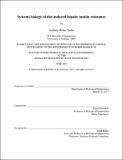| dc.contributor.advisor | Ernest Fraenkel. | en_US |
| dc.contributor.author | Soltis, Anthony Robert | en_US |
| dc.contributor.other | Massachusetts Institute of Technology. Department of Biological Engineering. | en_US |
| dc.date.accessioned | 2017-09-15T14:22:19Z | |
| dc.date.available | 2017-09-15T14:22:19Z | |
| dc.date.copyright | 2017 | en_US |
| dc.date.issued | 2017 | en_US |
| dc.identifier.uri | http://hdl.handle.net/1721.1/111272 | |
| dc.description | Thesis: Ph. D., Massachusetts Institute of Technology, Department of Biological Engineering, 2017. | en_US |
| dc.description | This electronic version was submitted by the student author. The certified thesis is available in the Institute Archives and Special Collections. | en_US |
| dc.description | Cataloged from student-submitted PDF version of thesis. | en_US |
| dc.description | Includes bibliographical references (pages 192-205). | en_US |
| dc.description.abstract | Human obesity is a world-wide health crisis that promotes insulin resistance and type 2 diabetes. Obesity increases intracellular free fatty acid concentrations in peripheral tissues, particularly the liver, which disrupts molecular mechanisms that maintain normal glycemia in response to fasting and feeding. The progression towards outright pathology in response to obesity is a highly complex process that involves coordinated dysregulation of a variety of molecular processes across multiple regulatory levels. The goal of this thesis was to apply a quantitative, multi-omic systems biology approach to the study of obesity-induce hepatic insulin resistance. We fed male C57BL/6J mice high-fat diets (HFD) to induce obesity and insulin resistance. In the first presented study, our group collected datasets to profile the hepatic epigenomes, transcriptomes, proteomes, and metabolomes of chow diet (CD) control and HFD-fed mice. I extended and applied an established computational modeling algorithm, namely the prize-collecting Steiner forest (PCSF), to simultaneously integrate these molecular data with protein-protein and protein-metabolite interactions into a tractable network model of hepatic dysregulation. This model uncovered a variety of dysregulated pathways and processes, some of which are not well-established aspects of insulin resistance. We further tested and validated some of these model predictions, finding that HFD induces serious architectural defects in the liver and enhances hepatocyte apoptosis. In the next study, we focused more specifically on hepatic transcription. We fed mice short and long-term HFDs and treated them with the type 2 diabetes drug metformin. Compared to non-treated CD controls, diet exerted the strongest effect on transcription, progressively inducing changes as HFD duration increased. We additionally stimulated mice with insulin and collected temporal transcriptomic profiles. We found that long-term HFD almost completely blunted normal insulin-induced transcriptional changes, but also found a small set of genes that are specifically insulin-responsive in HFD livers. We further characterized one of these genes and provided evidence supporting the notion that aspects of hepatic insulin signaling are intact during insulin resistance. In another study, we collected transcriptomic and epigenomic data from mice fed a calorie-restricted (CR) diet. Interestingly, we found a small set of genes altered in the same direction by both CR and HFD. We then used chromatin accessibility experiments to infer regulators associated with these gene expression changes and found roles for PPAR[alpha] and RXR[alpha]. We performed ChIP-Seq experiments for these factors and treated mice and primary hepatocytes with a PPAR[alpha] activator, uncovering a role for PPARα in the regulation of anaerobic glycolysis. We also validated novel predicted target genes of PPAR[alpha] involved in glucose metabolism. Finally, we profiled hepatic miRNAs in CD and HFD livers, finding that HFD progressively alters their expression levels. We implemented an enrichment procedure and a network modeling approach to analyze these data. We integrated additional mRNA and epigenetic data to infer miRNAs that may play regulatory roles during insulin resistance. In total, this thesis presents a unique comprehensive approach to the study of diet-induced hepatic insulin resistance that revealed new insights into pathology. | en_US |
| dc.description.statementofresponsibility | by Anthony Robert Soltis. | en_US |
| dc.format.extent | 205 pages | en_US |
| dc.language.iso | eng | en_US |
| dc.publisher | Massachusetts Institute of Technology | en_US |
| dc.rights | MIT theses are protected by copyright. They may be viewed, downloaded, or printed from this source but further reproduction or distribution in any format is prohibited without written permission. | en_US |
| dc.rights.uri | http://dspace.mit.edu/handle/1721.1/7582 | en_US |
| dc.subject | Biological Engineering. | en_US |
| dc.title | Systems biology of diet-induced hepatic insulin resistance | en_US |
| dc.type | Thesis | en_US |
| dc.description.degree | Ph. D. | en_US |
| dc.contributor.department | Massachusetts Institute of Technology. Department of Biological Engineering | |
| dc.identifier.oclc | 1003323526 | en_US |
